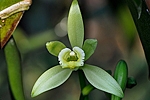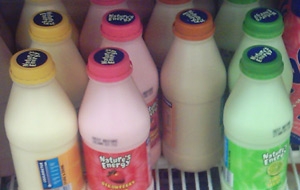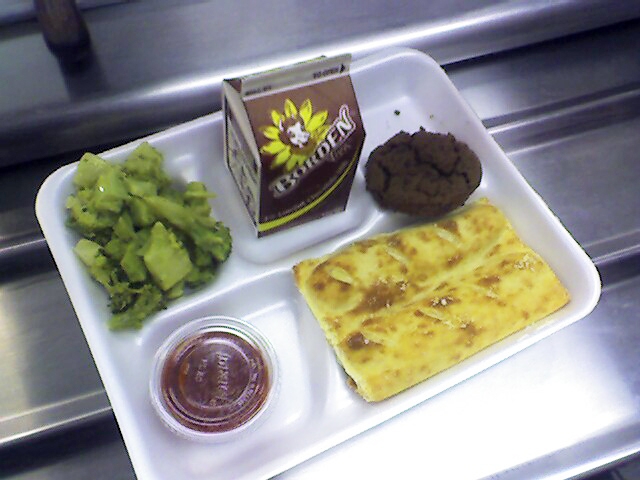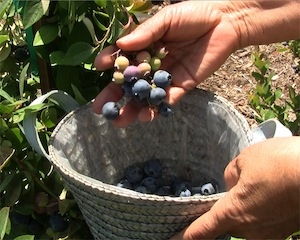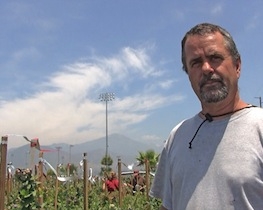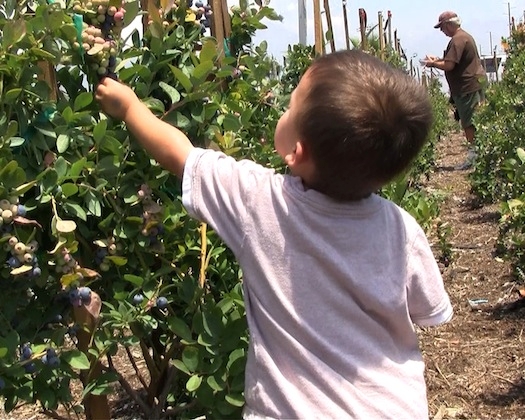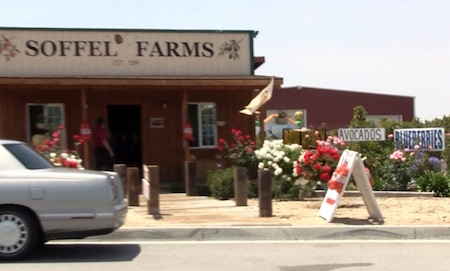UC Food Blog
Nothing plain about this UC Davis vanilla research
There is good news for those who are wild about all things vanilla – from ice cream to candy and even savory foods.
One of the world’s most popular flavors, vanilla comes from vanilla beans, which are grown in Madagascar, Mexico and other tropical regions. Unfortunately, vanilla farmers in these regions struggle to overcome low prices, a fungal disease epidemic, climate stress and environmental deterioration.
UC Davis scientist Sharman O’Neill is working to overcome some of these problems by carrying out genomic research to improve commercial vanilla plants and their sustainable cultivation in Madagascar.
Her efforts were recently recognized by the global food company General Mills, which named O’Neill the national winner of the General Mills Sustainability Challenge, a call for universities’ best ideas for reducing waste, encouraging sustainable consumption and using resources responsibly.
The honor comes with $200,000 to support the genomic vanilla research through O’Neill’s Vanilla Sustainability Project in UC Davis’ College of Biological Science.
The researchers aim to improve the genetic basis of the vanilla-bean crop so that vanilla farmers can overcome the problems posed by disease, climate stress, market uncertainties and environmental decline.
There is a lot at stake here because if these farmers abandon vanilla and change to other crops, the tropical forests, where the vanilla vines grow in compatible agroforestry systems, would likely be cut down. That would destabilize the critical habitat of innumerable plants and animals, including precious species of lemurs in northeastern Madagascar, the major vanilla-producing country.
"General Mills' goal is to maintain a strong, sustainable supply of high-quality vanilla beans," said Steve Peterson, director of sourcing sustainability at General Mills. "That's what this project is all about."
O’Neill’s vanilla research team involves an international group of scientists from the J. Craig Venter Institute in the United States; the French research center CIRAD on Réunion Island; the University of Antananarivo in Madagascar; the Instituto Nacional de Investigaciones Forestales, Agricolas y Pecuarias /SAGARPA in Mexico; and other international collaborators.
As part of the project, the scientists plan to use cutting-edge genomic sequencing and mapping technologies, in combination with traditional plant-breeding methods, to develop improved and new vanilla varieties that are hardier, more disease-resistant and offer enhanced flavor. A separate element of the project will also advance efforts to promote a more equitable model for sustainable vanilla cultivation with General Mills’ business partners.
The great flavored milk debate
Back in January, British chef and TV personality Jamie Oliver filled an old school bus with 57 tons of white sand in a parking lot in Carson, Calif. What was the purpose of this exercise, you might ask? The sand was meant to represent the amount of sugar in flavored milk. More specifically, the amount of sugar children in the Los Angeles Unified School District consume in a week’s time from flavored milk provided in their school lunches.
There has been much talk about flavored milk in recent months, and much of this debate has been fueled by Jamie Oliver who has a popular television show, Jamie Oliver’s Food Revolution, on ABC. His goal is simple: "To revolutionize school lunches to save the health of America’s next generation." Oliver launched a “sugary milk campaign” back in April, 2011. The purpose of the campaign is to ask schools to promote plain white milk instead of flavored milks. According to Oliver’s website, “chocolate milk has the same amount of sugar as a soft drink and just one additional soft drink per day increases a child’s obesity risk by 60 percent and is a major contributor to Type 2 diabetes.”
Well before Oliver emerged on the scene, people have debated the merits of offering flavored milk in the school lunch program. Chocolate (the most common), strawberry, vanilla and other interesting flavors are widely available in districts across the country. The milk provides essential nutrients, but with that comes added sugars that contribute extra calories to the diet – something most American children do not need.
Is there a place for flavored milk on the school lunch tray?
According to the American Dietetic Association, the Dairy Council and other health and nutrition organizations – the answer is yes.
Supporters of flavored milk in schools argue that it provides nine essential nutrients – unlike sodas and other sweetened beverages that offer no nutritional benefit besides extra calories.
According to the American Dietetic Association, leading health and nutrition organizations (including the American Academy of Family Physicians, American Academy of Pediatrics, American Heart Association, National Hispanic Medical Association, National Medical Association and School Nutrition Association) recognize the role that low-fat or fat free milk (including flavored milk) plays in helping kids achieve daily dairy serving recommendations. According to the ADA, kids will drink more milk when it’s flavored and kids drink less milk (and get fewer nutrients) when flavored milk is taken away.
The Diary Council offers an overview for school nutrition professionals in favor of flavored milk on the lunch tray. The Dairy Council of California argues that we cannot forget flavored milk has both natural sugars (lactose) and added sugar, and the amount of high-fructose corn syrup added to flavored milk is much less than the amount added to sugary beverages like soda or other processed foods. Additionally, some studies suggest that kids who drink flavored milk are less likely to consume soda and other sugary beverages, they consume more nutrients and are more likely to maintain a healthy body weight.
Where does LAUSD, the school district placed at the center of this debate, stand?
Last Tuesday, the board voted to eliminate flavored milk from its school lunch program. This new policy will affect 650,000 students who receive meals from LAUSD every day. This will spare flavored milk-drinking students an additional 6-12 grams of sugar (or 1 ½ - 3 teaspoons) a day, should they have chosen chocolate or strawberry milk over plain low-fat milk.
The burning question we all want to know the answer to now is, will LAUSD students switch over to low fat or fat free plain milk when chocolate or strawberry milk is no longer available in the fall? The answer will be very interesting and perhaps will put an end to the great flavored milk debate!
For foodies, being choosier is getting easier and fun
This season, for Southern California pick-your-own foodies, blueberries are among the latest and fastest growing offerings, thanks to the tenacity of small-scale farmers and the know-how provided by UC Agriculture and Natural Resources experts.
Although U-pick produce operations have been around for many years, farmers who let you hand-pick your blueberries was unheard of in this part of the state until recently.
We may have to thank UC Cooperative Extension farm advisor Manuel Jiménez, who's work on cultivars that he planted in 1997 at the UC Kearney Agricultural Research and Extension Center in Parlier has resulted in about 30 million pounds harvested in about 6,000 acres this year in California, mostly in the San Joaquín Valley.
A few days ago, my wife, Sylvia, and I decided to try our hand at picking our own berries at Soffel Farms in Redlands. It's one of the few local urban farms, or rather farms that became urban in the Inland Empire Area, which is San Bernardino and Riverside counties.
For the second year in a row, Soffel Farms is letting customers harvest as much as they want of its blueberries. This year, Ron Soffel is seeing people who drive more than a hundred miles to do just that.
"They don't see these around here, the closest are when you go up north to the San Joaquín Valley," he said of the blueberries as a new local crop.
By word of mouth, and of quite a few bloggers, locals and not so locals are showing up to pick the micro-nutrient rich blueberries, which many foodies see as magic pills in the fight against some types of cancer and obesity-related diseases like diabetes.
Of course, an incredible flavor helps too. For sure, pickers leave with a better understanding of what it's like to grow and harvest the foods that keep us healthy.
"Once they come up, and experience it, they come back," said Soffel.
Soffel Farms operates very much like other U-pick small-scale farms that are benefiting from agritourism, which UC small farm program has helped to develop to assist local growers. You check in, they give you a little basket and a couple of pointers:
- Walk carefully along the rows of bushes so do not damage the plants.
- Get only the ones that are purple; place the basket under the berries and gently roll your thumb over a berry to make it fall in the basket. (They do, just as if they were waiting for you!)
After you've picked enough, you go back and your berries are packed in 12 oz. plastic containers for which you pay $5 each.
I confess, my wife and I didn't wait until we got home to make sure we had gotten the most delicious blueberries we'd ever tasted! Once you taste a handpicked blueberry, it's hard not to eat some of the ones that should go into the basket.
I felt less guilty after seeing Soffel do the same as we spoke. Other visitors did it too, including a five-year-old who was accompanied by his grandparents, from San Diego. None of his blueberries went to a basket, but straight to his tummy.
"Purple!" he told me every time he put one in his mouth as we went along picking berries. He was the proverbial kid in a candy store. Thank goodness there was lots of that Mother Nature's candy.
As a consumer, I'm thankful that we have our own Manuel Jiménez, who tirelessly proved that blueberries could and should be added to the California cornucopia. And also for the determination of small growers like Soffel in keeping the agriculture tradition alive.
Although many farmers in California are now finding that blueberries are relatively easy to grow, Soffel says it's labor intensive. But it's helping him to keep his family tradition. Like many small-scale farmers, Soffel depends on direct sales. Adding blueberries to his pick-your-own operation, which includes a few acres of orange trees and avocados, is so far proving to be a good source of income, he said.
Soffel is typical of the decreasing number of local growers. They are constantly threatened by urbanization and its accompanying regulations. Soffel is a fifth generation farmer whose ancestors came from Oregon by wagon. The Stoffel Farms sign reads, "Established in 1914." Soffel says his family was among the pioneers that made the Redlands area famous for its oranges.
Most orange groves are gone and have been replaced by housing and commercial buildings; but Soffel and his family refuse to cut their roots to farming.
"I'll be a farmer forever," he told me.
I hope so. I'm waiting for word about his avocados being ready for picking.
(Photos: Alberto Hauffen)
Don't forget dairy
Drinking a glass of non-fat or 1% milk will help soothe the day’s tensions and make you sleep better at night, but the benefits go far beyond its calming properties, says UC Cooperative Extension nutrition educator Ellen Sandor.
“The calcium in milk reduces muscle spasms and calms stress,” Sandor said. “Plus milk and other dairy products, like cheese and yogurt, are excellent sources of calcium, potassium and vitamin D, which help maintain bone health.”
The USDA 2010 Dietary Guidelines for Americans recommends three servings of non-fat or low fat dairy products per day. In fact, milk’s importance is creatively highlighted is USDA’s new “MyPlate” nutrition icon. MyPlate clearly illustrates that a healthful diet can be achieved by filling half a plate with fruits and vegetables, and splitting the other half between grains and slightly less protein. Dairy products are shown in a separate circle, invoking a glass of milk or cup of yogurt to accompany the meal.
Sandor said USDA recommends all children and adults drink non-fat, 1% or 2% milk except children under 2 years old. The amount of calcium in non-fat and low-fat milk is exactly the same as in whole milk, however, whole milk has 9 grams of fat and 157 calories. A cup of non-fat milk has 86 calories.
Additionally, fat in whole milk is the unhealthful saturated type, which boosts the levels of bad cholesterol in the blood, raising the risk of developing coronary heart disease. Whole milk and milk products can also contribute to overweight.
Even though it’s widely understood that milk is important for good health, children and adults in the United States are, by and large, not consuming the amount recommended by the USDA’s Dietary Guidelines. Sandor said it is important to teach children to eat dairy products daily so it will be easier for them to consume them as adults.
She suggests the following ideas to promote the consumption of dairy products:
- Offer children low-fat yogurt with fruits and vegetables as a snack or desert.
- Suggest that drink machines at your children’s school include milk products.
- Offer lactose-free milk or foods fortified with calcium to children who do not tolerate milk.
- Consider arranging for your child to eat the school lunch. Children that eat school lunch drink more milk than those that bring their lunch.
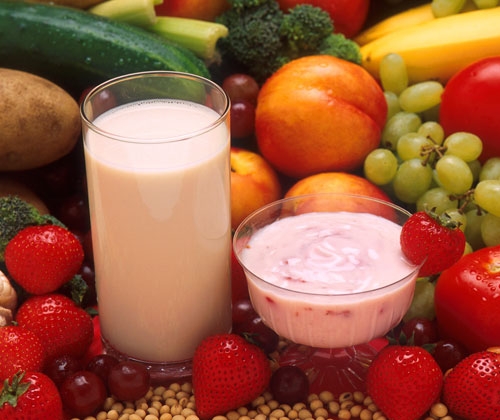
Dairy products are a fundamental part of a healthful diet.
It's a fruit...It's a mandarin...It's ‘KinnowLS’!
On the Jeopardy show, the clues could easily be: “It’s new and attractive. It’s juicy and sweet. And it’s low-seeded and peels easily.”
To which the answer would be, “What is ‘KinnowLS’?”
‘KinnowLS’ – the LS is short for low seeded – is the latest citrus variety released by researchers at the University of California, Riverside.
Large-sized for a mandarin, the fruit has an orange rind color. The rind is thin and extremely smooth. The 10-11 segments in each fruit are fleshy and deep orange in color.
‘KinnowLS’ matures during February through April, and does well in hot climates. It was developed by mutation breeding of the mandarin cultivar ‘Kinnow,’ a mid-to-late season maturing variety developed by UC Riverside nearly 100 years ago. While ‘Kinnow’ has 15-30 seeds per fruit, ‘KinnowLS’ has only 2-3 seeds per fruit.
“People who like very sweet fruit are going to find ‘KinnowLS’ to be very appealing,” says Mikeal Roose, a professor of genetics, who developed ‘KinnowLS’ along with staff scientist Timothy Williams. “When other citrus varieties mature to reach the level of sweetness of ‘KinnowLS,’ their other qualities – such as rind texture – are in decline. Neither ‘Kinnow’ nor ‘KinnowLS’ suffer in this way.”
Yet another attractive quality of ‘KinnowLS’ is that it can be grown in California’s desert regions because the fruit, which matures during February through April, does well in hot climates.
Indeed, ‘Kinnow’ is the most important mandarin in the Punjab regions of India and Pakistan, where ‘Kinnow’ fruit trees constitute about 80 percent of all citrus trees.
“But the fruit, which is popular there, is seedy,” Roose says. “Therefore, ‘KinnowLS’ has very good potential in this area of the world.”
Growers in India and Pakistan will have to wait a few years, however, before ‘KinnowLS’ trees can strike roots there. Currently, plans are to distribute ‘KinnowLS’ budwood, starting this month, to only licensed nurseries in California. (For three years, only California nurseries will be permitted to propagate ‘KinnowLS.’ Licenses for ‘KinnowLS’ propagation outside the United States will be issued thereafter.)
So when will we find ‘KinnowLS’ in U.S. produce aisles?
Alas, not for at least five years. It generally takes about that long to propagate citrus trees.
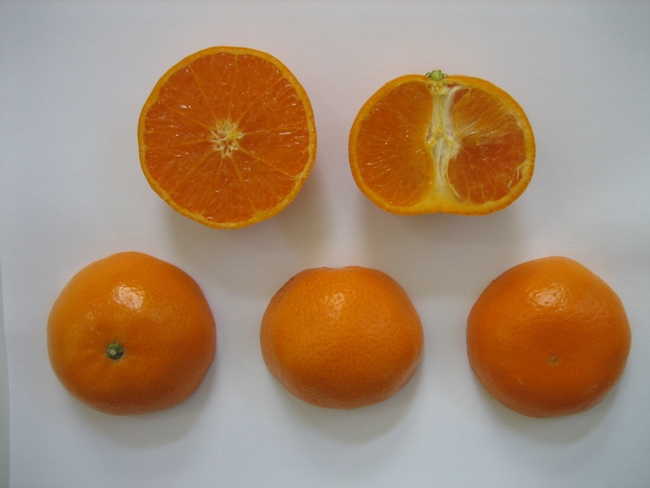
2602 1hi


